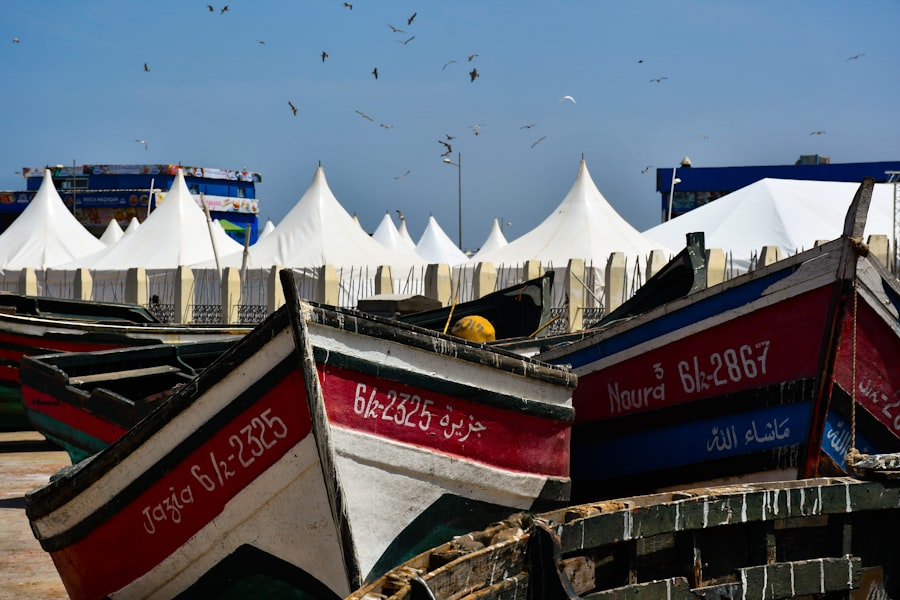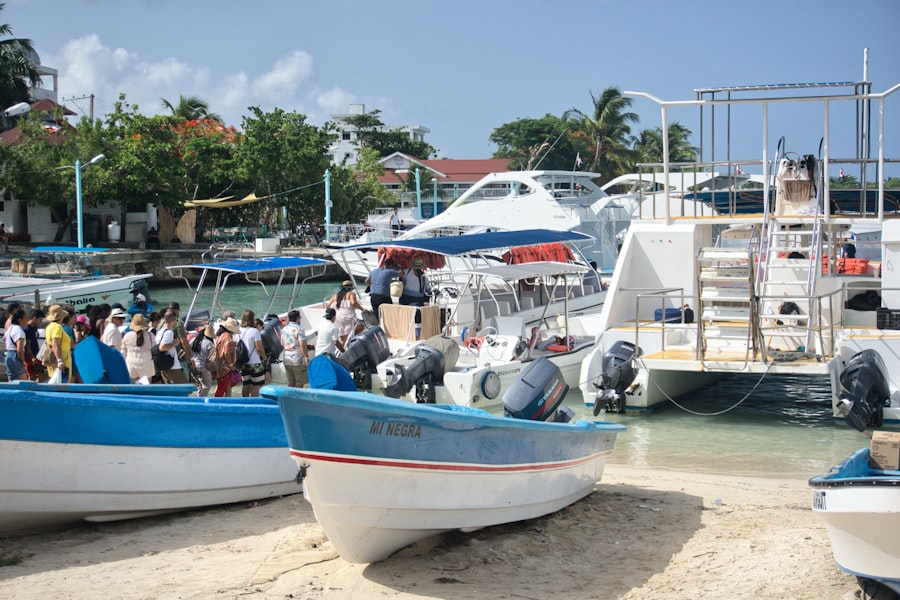The leisure boat market has experienced significant fluctuations over the past few years, influenced by various economic, social, and environmental factors. As of 2023, the market is witnessing a resurgence in demand, primarily driven by a growing interest in outdoor recreational activities. The COVID-19 pandemic played a pivotal role in this shift, as many individuals sought safe and socially distanced ways to enjoy their leisure time.
This resulted in a surge in boat sales, with manufacturers struggling to keep up with the heightened demand. According to industry reports, the global leisure boat market was valued at approximately $30 billion in 2022 and is projected to grow at a compound annual growth rate (CAGR) of around 5% over the next several years. In addition to the pandemic’s impact, the leisure boat market is also being shaped by changing consumer preferences.
There is a noticeable shift towards more sustainable and eco-friendly boating options, as consumers become increasingly aware of their environmental footprint. Electric and hybrid boats are gaining traction, with manufacturers investing in research and development to create more efficient and environmentally friendly vessels. Furthermore, the rise of digital technology has transformed how consumers engage with the boating industry, from online sales platforms to virtual reality experiences that allow potential buyers to explore boats before making a purchase.
This evolving landscape presents both challenges and opportunities for stakeholders within the leisure boat market.
Key Takeaways
- The leisure boat market is shaped by evolving consumer preferences and economic factors.
- Key trends include growing interest among younger demographics and demand for eco-friendly boats.
- Buyers face challenges like rising costs but can leverage opportunities through market innovations.
- Selecting the right boat depends on individual needs, usage, and lifestyle considerations.
- Financing, maintenance, safety, and regulatory compliance are critical aspects to ensure a positive boating experience.
Identifying Key Trends and Demographics in the Leisure Boat Market
Understanding the demographics of leisure boat buyers is crucial for manufacturers and retailers aiming to tailor their offerings effectively. Traditionally, the leisure boating demographic has skewed towards older individuals, particularly those aged 50 and above, who often have the disposable income necessary for such purchases. However, recent trends indicate a shift towards younger buyers, particularly millennials and Gen Z consumers.
These younger generations are increasingly interested in experiences over material possessions, leading them to seek out recreational activities like boating that offer adventure and connection with nature. Moreover, the trend towards inclusivity in outdoor activities is reshaping the market. Companies are recognizing the importance of catering to diverse audiences, including women and families.
This has led to the development of more user-friendly boats that are easier to operate and maintain, making them accessible to novice boaters. Additionally, marketing strategies are evolving to reflect this inclusivity, with brands actively promoting diverse representations in their advertising campaigns. The rise of social media has also played a significant role in shaping consumer behavior, as potential buyers often turn to platforms like Instagram and TikTok for inspiration and recommendations on leisure boating experiences.
Navigating the Challenges and Opportunities in the Leisure Boat Market

While the leisure boat market is experiencing growth, it is not without its challenges. One of the most pressing issues facing the industry is supply chain disruptions. The pandemic highlighted vulnerabilities in global supply chains, leading to delays in production and increased costs for manufacturers.
This has resulted in longer wait times for consumers looking to purchase new boats, which can deter potential buyers who may opt for alternative recreational activities instead. Additionally, rising material costs have put pressure on manufacturers to balance quality with affordability, further complicating the market landscape. Despite these challenges, there are numerous opportunities for innovation and growth within the leisure boat market.
The increasing focus on sustainability presents a unique chance for manufacturers to differentiate themselves by offering eco-friendly options. As consumers become more environmentally conscious, there is a growing demand for boats that utilize renewable energy sources or incorporate sustainable materials into their construction. Furthermore, advancements in technology are paving the way for smarter boats equipped with features such as automated navigation systems and enhanced connectivity options.
These innovations not only improve the overall boating experience but also attract tech-savvy consumers who prioritize modern conveniences.
Choosing the Right Type of Leisure Boat for Your Needs
| Boat Type | Primary Use | Capacity | Typical Length (ft) | Skill Level Required | Maintenance Level | Cost Range |
|---|---|---|---|---|---|---|
| Fishing Boat | Freshwater and saltwater fishing | 2-6 people | 14-24 | Beginner to Intermediate | Moderate | Low to Medium |
| Pontoon Boat | Leisure cruising and social gatherings | 6-12 people | 16-30 | Beginner | Low | Medium |
| Ski/Wakeboard Boat | Water sports like skiing and wakeboarding | 4-8 people | 18-25 | Intermediate | High | Medium to High |
| Sailboat | Recreational sailing and racing | 1-8 people | 15-40 | Intermediate to Advanced | High | Medium to High |
| Cabin Cruiser | Overnight trips and extended cruising | 4-10 people | 25-45 | Intermediate | High | High |
| Jet Boat | High-speed water activities and shallow waters | 4-7 people | 14-22 | Beginner to Intermediate | Moderate | Medium |
Selecting the right type of leisure boat is a critical decision that depends on various factors, including intended use, budget, and personal preferences. The market offers a diverse range of options, from small inflatable boats ideal for fishing trips to luxurious yachts designed for extended cruising. For those who enjoy water sports such as wakeboarding or waterskiing, a powerboat with sufficient horsepower is essential.
Conversely, individuals seeking a tranquil experience on calm waters may prefer a sailboat or pontoon boat that emphasizes stability and comfort. When considering budget constraints, it is important to factor in not only the initial purchase price but also ongoing costs such as insurance, maintenance, and storage fees. For first-time buyers, smaller boats or used models can provide an affordable entry point into the world of leisure boating without overwhelming financial commitments.
Additionally, prospective buyers should assess their level of experience and comfort with operating different types of vessels. Many manufacturers offer training programs or resources to help new boaters develop their skills and confidence on the water.
Exploring Financing Options for Purchasing a Leisure Boat
Financing a leisure boat purchase can be a complex process that requires careful consideration of various options available to buyers. Traditional bank loans are one of the most common methods for financing a boat purchase; however, they often come with stringent credit requirements and may not be suitable for all buyers. Many financial institutions offer specialized marine loans that cater specifically to boat purchases, providing more flexible terms and competitive interest rates tailored to the unique needs of boaters.
In addition to traditional financing options, buyers may also explore alternative methods such as leasing or renting before committing to a purchase. Leasing allows individuals to enjoy the benefits of boating without the long-term financial commitment associated with ownership. This can be particularly appealing for those who are unsure about their long-term interest in boating or who wish to test different types of vessels before making a significant investment.
Furthermore, some manufacturers offer financing directly through their dealerships, which can simplify the purchasing process by providing one-stop shopping for both the boat and financing options.
Understanding Maintenance and Storage Considerations for Leisure Boats

Proper maintenance is essential for ensuring the longevity and performance of leisure boats. Regular upkeep not only enhances safety but also preserves the vessel’s value over time. Key maintenance tasks include routine inspections of the engine, hull, and electrical systems; cleaning and polishing surfaces; and checking safety equipment such as life jackets and fire extinguishers.
Many boat owners choose to hire professional services for more complex maintenance tasks or winterization processes, particularly if they lack experience or time. Storage considerations are equally important when it comes to leisure boats. Depending on geographic location and climate conditions, owners must decide whether to store their boats in-water or on land during off-seasons.
In-water storage can expose boats to harsh weather conditions that may lead to damage if not properly protected. On the other hand, land storage often requires additional considerations such as securing adequate space and ensuring proper support structures are in place to prevent damage during storage periods. Additionally, owners should be aware of local regulations regarding storage practices and any associated fees.
Navigating Safety and Regulatory Requirements in the Leisure Boat Market
Safety is paramount in the leisure boating industry, necessitating adherence to various regulations designed to protect both boaters and marine environments. Each country has its own set of laws governing boating safety equipment requirements, licensing procedures for operators, and environmental regulations aimed at preserving aquatic ecosystems. In many regions, boaters are required to carry specific safety gear such as life jackets, flares, fire extinguishers, and sound signaling devices on board at all times.
Furthermore, operators may need to complete safety courses or obtain licenses before operating certain types of vessels. These requirements vary widely depending on factors such as boat size and horsepower as well as local laws governing waterways. Staying informed about these regulations is crucial for ensuring compliance and avoiding potential fines or penalties while promoting safe boating practices among all participants.
Exploring New Technologies and Innovations in the Leisure Boat Market
The leisure boat market is undergoing a technological revolution that is transforming how boats are designed, built, and operated. Innovations such as electric propulsion systems are gaining popularity as manufacturers respond to consumer demand for greener alternatives that reduce reliance on fossil fuels. Electric boats not only minimize environmental impact but also offer quieter operation and lower maintenance costs compared to traditional combustion engines.
Additionally, advancements in navigation technology have made it easier than ever for boaters to explore new waters confidently. Modern GPS systems provide real-time tracking capabilities while integrated chartplotters offer detailed maps that enhance navigation accuracy. Furthermore, smart technology is making its way into leisure boats through features like automated docking systems and remote monitoring applications that allow owners to check on their vessels from anywhere via smartphone apps.
As these technologies continue to evolve, they promise to enhance safety measures while improving overall user experience on the water—making leisure boating more accessible than ever before for both seasoned enthusiasts and newcomers alike.


